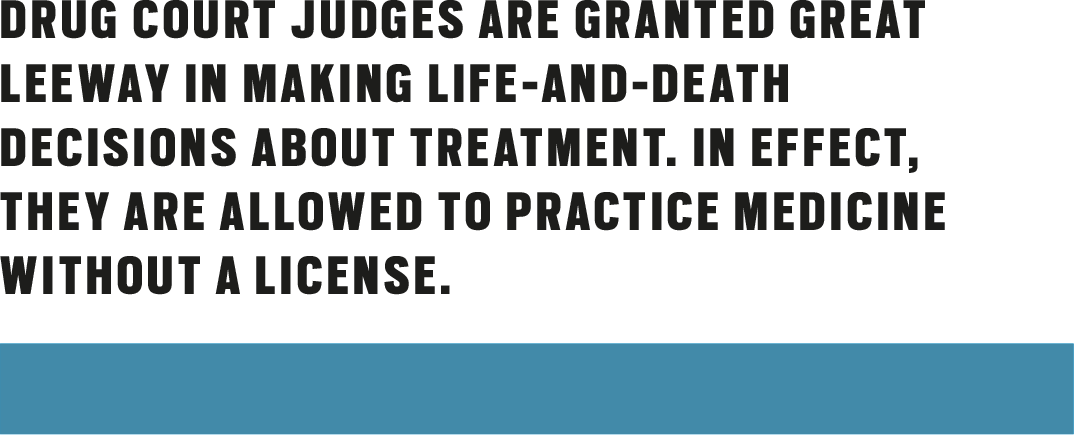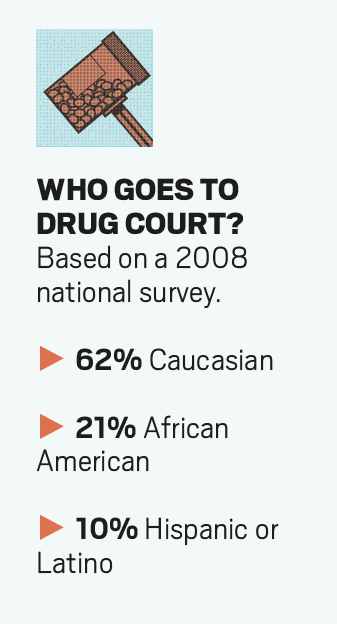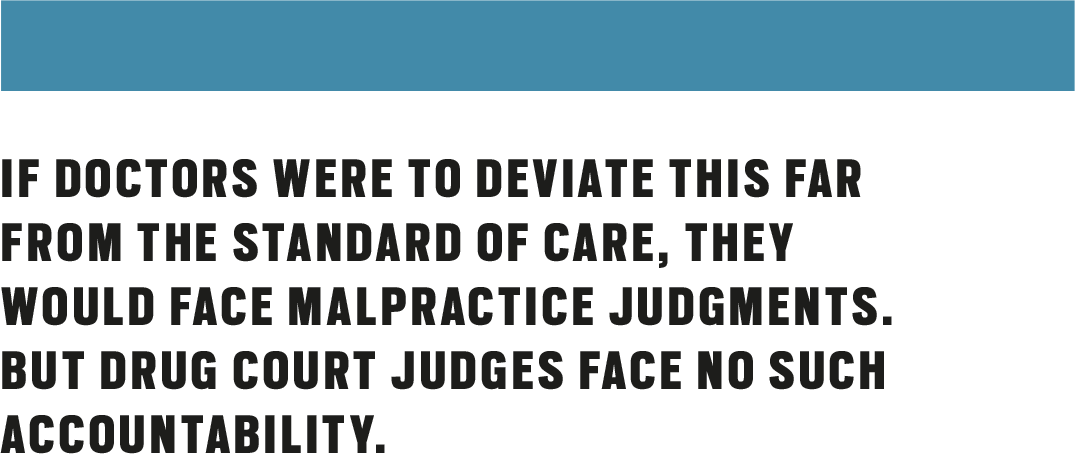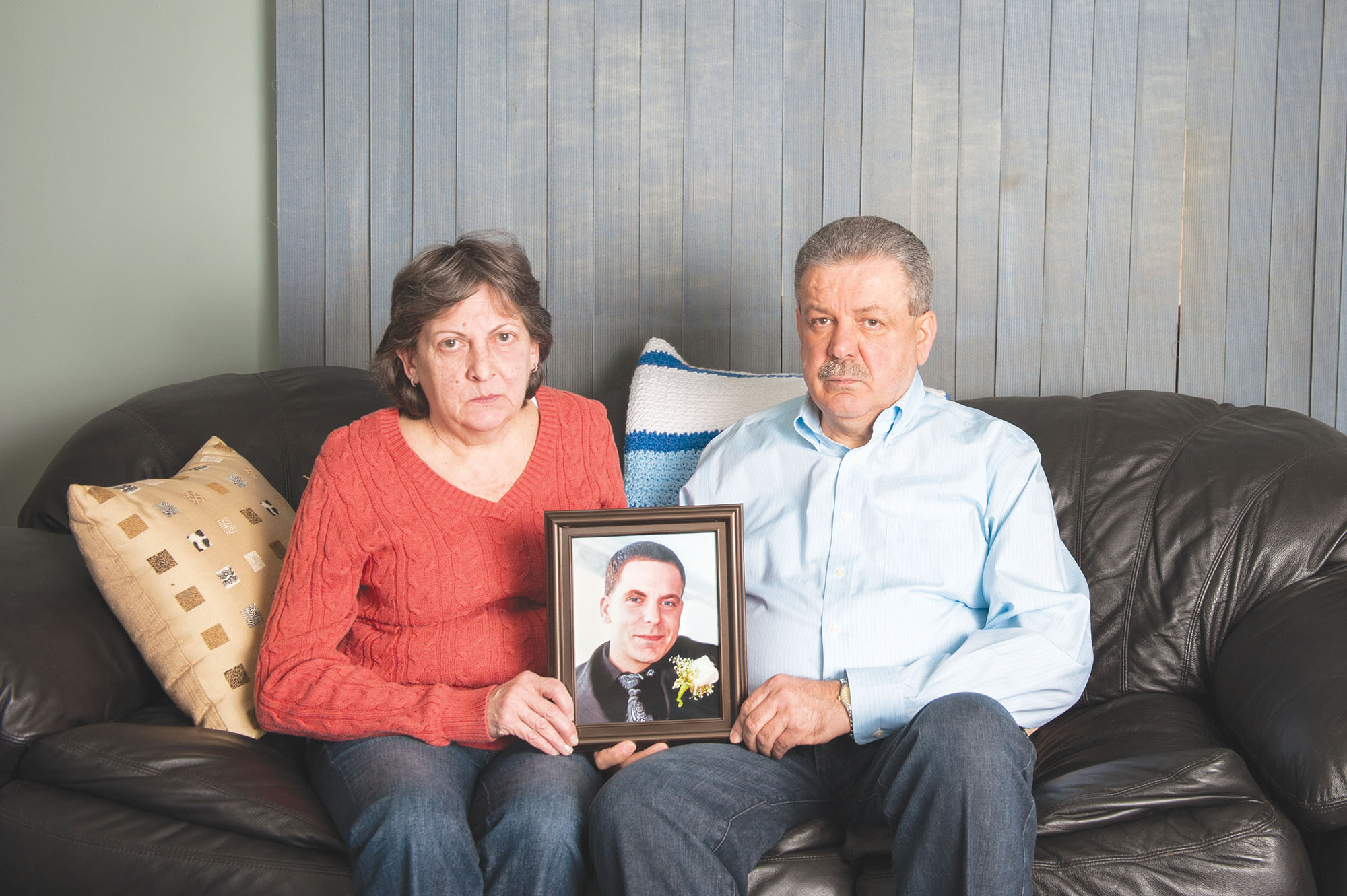When Ellen Sousares learned that her 22-year-old son, Darren, had been arrested in 2014 for felony possession of heroin and diverted into drug court, she wasn’t upset or ashamed. She was overjoyed. Darren had been addicted to heroin for six years. At the time of his arrest, he was living on the street in Colorado, far from her home in California. He’d already overdosed seriously enough to require emergency care at least six times. He had repeatedly tried rehab, but he’d never stayed long enough to get his mental health properly evaluated. Finally, Ellen thought, he’d be forced to get the help he really needed.
Drug courts celebrated their 25th anniversary last year. Designed for defendants who have committed non-violent felonies such as drug dealing or burglary while addicted, they have been touted as a perfect balance of treatment and punishment, and as a way for the most corrigible offenders to avoid the harsh sentences mandated by drug-war laws. The idea is appealingly simple. If defendants complete a program of drug testing and mandatory treatment—often including short jail terms, known as flash incarcerations, in the case of serious rule violations—they can avoid lengthy mandatory prison terms. Those who fail to “graduate” from the program, in the self- improvement-geared parlance of drug courts, face the mandated sentence, or sometimes an even harsher one. Coercion, the theory goes, is the key to rehabilitation.
More than 2,800 drug courts now exist in the United States, serving approximately 120,000 defendants annually. They enjoy broad political popularity, with supporters ranging from William Bennett and Newt Gingrich on the right to Al Franken and the Clintons on the left. George W. Bush and Barack Obama both expanded funding for them. The press loves them too. Until very recently, it’s been hard to find a newspaper or a magazine that has taken a position on the issue other than hearty endorsement. There’s even a sense nationally that drug courts produce better results than voluntary treatment. In 2008, when voters in California were considering a proposition designed to use less punishment and more treatment in handling drug offenders, Governor Jerry Brown recommended voting against it because, he claimed, less-punitive sentencing would hurt drug courts. “We know that the hammer of incarceration is often what is needed,” he said, “to assist an addict to get off his dependency.”

At first glance, the statistics suggest that drug courts deserve this unusual bipartisan enthusiasm. According to the website of the National Association of Drug Court Professionals, 75 percent of those who successfully complete drug court “remain arrest-free at least two years after leaving the program,” and for every dollar invested in drug court, “taxpayers save as much as $3.36 in avoided criminal justice costs alone.”
It’s not surprising, then, that Ellen Sousares felt that drug court was the perfect solution for Darren. (Their names have been changed for this story.) It would treat his addiction as a disease and match him to appropriate care, while using the threat of prison to motivate him to stick with it. As a mom, she felt relieved that her son would be safe, at the very least, and that he would finally be forced to stay in treatment long enough for the professionals to find out what would actually work for him.
But within a few weeks she began to worry that drug court might be doing Darren far more harm than good. And many others have started to feel the same way.

Darren’s problems started long before he ever tried heroin. A painfully shy child, he was diagnosed with attention deficit hyperactivity disorder in the third grade. “He was always really active, running around, climbing trees,” says Ellen. “I just couldn’t gather him up.”

Although Darren loved studying history, he suffered intense fears and anxieties, and had a hard time with schoolwork. He seemed to find solace only in playing the guitar. At times, Ellen wondered whether his fears and anxieties were signs of mental illness. With a family history of bipolar disorder, Ellen worried that her son might be genetically vulnerable. Research shows that such a history can increase risk for addictions.
Darren was first arrested, for marijuana use, at around age 14 or 15. A judge sentenced him to a rehab program, where he met people with more serious drug problems, including heroin users. His first overdose—stemming from a mixture of heroin and prescription pills—came at 17. “His respirations were down to six to seven a minute,” Ellen recalls. “He almost died that day.” Many more overdoses followed. Over the next few years, Ellen had to tell Darren to stop calling her from the ER after each one, because she couldn’t bear knowing how often he was close to death.
After the arrest that got him placed in drug court, Darren was jailed for several days, during which time he suffered through the initial nausea, insomnia, and shakes of heroin withdrawal, which typically last at least two weeks. As a former emergency-room nurse, Ellen understood this process. She wasn’t especially pleased that he was being left to go cold turkey and denied medical treatment for his symptoms; however, she knew that jails aren’t designed to be hospitals or rehab clinics. But then came her first inkling that drug court itself was not what she had thought it would be: After 10 days, the judge decreed that Darren would be set free, still in active withdrawal, with an order to return in several days to visit the probation office.
This shocked and infuriated Ellen. From a medical perspective, Darren was now in a highly vulnerable state. When people who are addicted refrain from using heroin for over a week, they lose their built-up tolerance to opioids. A dose that a week ago barely produced a high might now be fatal. When such people are freed from custody without the proper treatment, as Darren was, their odds of a fatal overdose increase exponentially.
Ellen knew heroin addiction to be one of the deadliest of all psychiatric disorders, with an annual risk of death of one to three percent. And she knew that Darren’s risk was now glaringly acute. Homeless and still in active withdrawal, Darren had nowhere to go and nothing to do.
Alarmed, Ellen argued with probation officers and anybody else she could think to call, but to no avail. They all told her the same thing: “Everybody has to go through this system.”
Predictably, Darren didn’t show up for his meeting at the probation office. A warrant was issued, and he was quickly arrested. As punishment, he was given a flash incarceration of around 10 days. Then the cycle repeated itself: Again he was released, still in withdrawal, and told to turn up days later for a probation appointment; again he failed to show; and again he was arrested, briefly imprisoned, and released. Not long afterward, Ellen got the call. “All I know,” she says, “is that within hours of getting out of jail he overdosed on heroin and ended up in the ER.”

By the time Darren was assigned to drug court, his addiction story carried almost every possible red flag for high-mortality risk: prior overdose, prior treatment failure, a childhood ADHD diagnosis, and a family history of mental illness. Any addiction doctor—or anybody who simply follows evidence-based treatment guidelines—would know exactly what to prescribe for him: opioid maintenance, by far the most effective treatment, known to lower the death rate of opioid addiction by between 66 and 75 percent. Maintenance is the indefinite use of an opioid medication such as methadone or buprenorphine, typically combined with counseling. The World Health Organization has called it “essential medicine,” and the National Institutes of Health, the Institute of Medicine, and the White House Office of National Drug Control Policy have all endorsed it in various consensus statements. Even the National Association of Drug Court Professionals describes it on its website as a “best practice.” In 2000, after a defendant in a California drug court died of overdose after being denied maintenance, the state passed a law requiring drug courts to allow it.
But many drug court judges vociferously oppose the practice and require patients to become completely abstinent as a condition of participation or graduation. They believe that maintenance simply amounts to swapping one drug addiction for another. This critique betrays a fundamental misunderstanding of opioid pharmacology and addictive behavior. Left to their own devices, most addicted people take escalating and irregular amounts of their drug, creating a roller coaster of highs and lows that often precludes normal functioning. They’re either in withdrawal, actively seeking drugs, or wasted.
By contrast, maintenance evens out the highs and lows. If you take the same dose of an opioid at the same time daily for long enough, you become completely tolerant to it and experience no high or impairment at all. This is a unique property of opioid use; alcohol, for instance, doesn’t work this way, which is why it makes no sense to say, as critics frequently do, that swapping heroin for methadone is like swapping vodka for gin. On opioid maintenance, patients can drive, attend school, work demanding jobs, and experience the ordinary emotions of family life. Methadone and buprenorphine each have unique pharmacological properties that make them particularly useful for maintenance, but heroin itself is prescribed in Canada, the United Kingdom, and Switzerland for people who do not benefit from the other drugs. If stable maintenance dosing is achieved, it does not leave people numbed out or stoned, and is no more impairing than Prozac.
According to a 2012 study, only about a third of all drug courts permit participants to start maintenance as the treatment component of their program, and many oppose it. For example, the handbook for the Manhattan Treatment Court, which serves the city that has America’s largest number of heroin users, tells those hoping to enter the program, “You must agree to move from methadone to abstinence in order to participate.” In a hopeful sign, the Office of National Drug Control Policy announced in February that it would refuse to fund drug courts that apply for grants if they have such policies. They cited a lengthy exposé by the Huffington Post, which examined widespread problems with drug treatment in Kentucky, including a drug court judge who refused to allow maintenance, dismissing it as a substitute addiction, even though he admitted he was not “an expert on what works and what doesn’t work.”

Unfortunately, the ONDCP’s move may not lead to as much widespread change as one might think, in part because most drug courts are primarily funded by states or other localities, not the federal government. An even bigger obstacle is logistics: In most jurisdictions, jails, too, ban maintenance—at a rate far higher than drug courts do. This means that any flash incarceration would become, in effect, court-ordered withdrawal. Although the National Association of Drug Court Professionals says that a judge’s decisions must be based on “treatment and medical evidence,” it nevertheless strongly believes that judges should retain the discretion both to use flash incarceration and to decide on a case-by-case basis what treatments are acceptable.
Overwhelmingly, however, experts agree that opioid addiction is a health problem and that maintenance is the standard of care. Hundreds of studies show that it cuts death, crime, and blood-borne disease rates better than any alternative. A 2004 WHO summary of the data noted that crimes committed by those in their first year of methadone maintenance treatment are “reduced by around one-half.”
If doctors were to deviate this far from the standard of care in treating patients, they would face malpractice judgments and, in extreme cases, criminal prosecution. But drug court judges face no such accountability, even though they generally acknowledge that addiction is a disease and make final decisions on which treatments are permitted. “A judge’s decisions cannot be mucked about with unless they’re illegal or a total abuse of discretion,” says Peggy Hora, a retired drug court judge from California who has long argued in favor of maintenance. Unfortunately, this judicial independence, otherwise so crucial to the balance of democratic power, means that drug court judges—who are not required to have special training—can disregard the medical consensus. They are granted great leeway in making life-and-death decisions about treatment. In effect, they are allowed to practice medicine without a license.

Rudolf and Judith Lepolszki know all too well what can happen when drug courts deny access to maintenance, because they witnessed the effects on their 28-year-old son, Robert.
Robert had been a much-wanted child. His parents had struggled for seven years to conceive him and then had emigrated from Romania to Long Island in 1996, when he was 11, in order to give him a chance at a better life. “He was such a smart kid,” Rudolf recalls. Unfortunately, Robert got involved with drugs during high school, moving from marijuana to cocaine, then to pain pills, and finally to heroin. A series of arrests and attempts at drug-free rehab didn’t stop his addiction, but he kept trying to recover and eventually entered a methadone program. After a 2012 arrest, he was allowed to continue his medical treatment in jail, while serving an 80-day sentence in Suffolk County. On the day of his release, Rudolf drove him to a community-based methadone clinic, because the drug did seem to help him. Finally, Robert seemed to be turning a corner. For the first time in years, as Judith puts it, he was “doing great,” dutifully submitting to drug tests and attending Narcotics Anonymous meetings three days a week. He had even returned to his work in sales, earning excellent commissions. Like many young-adult immigrants, he lived with his parents, but that was a choice, not a necessity.
One Friday night, however, the police showed up at the Lepolszkis’ home, a three- bedroom house on a quiet suburban street in Farmingdale, New York, with a warrant for Robert’s arrest. Before he’d started methadone treatment, he’d sold a small amount of the anti-anxiety drug Xanax, which he’d been legitimately prescribed, and the police had now tracked him down, about a year after the crime.
Robert’s case now fell under the jurisdiction of the Nassau County drug court, where a judge decreed that in order to avoid more prison time, he would have to stop taking methadone—the only treatment that had ever helped him. Although Suffolk County had allowed him to take methadone even in jail, and Robert had responded well to it, Nassau’s drug court judge was philosophically opposed. A county line—not the data—thus determined his medical care.
Robert decided to taper off methadone rapidly, a more painful detox than is medically necessary, because he faced sanctions in court every time he tested positive for it. “He was suffering,” Rudolf recalls. Describing Robert’s response to the chills that occur in withdrawal, Judith adds, “It was like 90 degrees outside, and he was bathing in the sun, sweating, then taking hot showers.”

As he stopped the methadone, Robert cut ties with his drug-using friends, determined to avoid relapse. “He was frightened that he couldn’t stop,” Rudolf remembers. “He just had this addiction [and] he was fighting it.” He told his parents that he didn’t even want to make new friends at Narcotics Anonymous meetings, having seen how many of those attending were still using. But at one meeting, not long after he went cold turkey, he met a beautiful young woman, and the two soon became romantically involved. She wanted heroin. Soon, so did he.
Because of his recent abstinence, Robert was at extremely high risk for overdose—and, not surprisingly, it happened. One Saturday, after he had returned home from a Narcotics Anonymous meeting with his girlfriend, the two went up to his room and shot heroin. Rudolf had no idea what was happening until he heard the young woman come downstairs and call 911. Robert had stopped breathing.
The ambulance came quickly, and the EMTs were able to re-start Robert’s heart, but, sadly, the damage was done: Robert died four days later in the hospital. He was 28 years old. Because he’d signed an organ donor card, in dying he was at least able to save four lives.
Cases like Robert’s haunt Ellen Sousares, who knows of at least three other families who have lost children after drug courts denied access to maintenance or otherwise failed to take the risk of overdose into account. It’s impossible to know how pervasive a problem this is, however, because drug courts do not track mortality rates. “Nobody has that information,” says Herman Joseph, one of the world’s leading experts on maintenance and a member of the original team that developed methadone treatment. Joseph is convinced that the problem is widespread, and believes that what drug courts are doing is a travesty. “They are destroying lives,” he says, “and it’s horrible.”

The first drug court opened in Florida’s Miami-Dade County in 1989, near the height of the hysteria in this country over drugs, particularly crack cocaine. Both conservatives and liberals found something to love: Conservatives liked the potential for reduced prison spending, and liberals liked the emphasis on therapy. From the start, however, critics voiced concerns about “cherry picking,” because the courts only allowed into the program defendants who seemed likely to succeed whether or not they received help. This sort of selectivity was built into the system: The federal laws that determine eligibility for grants to create new drug courts (ongoing funding is primarily state and local) require that the courts exclude people with a history of violent crime. Many drug courts also bar people with long non-violent criminal histories. Predictably, this eliminates many of those who have the most serious addictions—the very people the courts, at least in spirit, are supposed to help.
Proponents of drug courts celebrate the fact that those who participate do better than similar defendants who are simply incarcerated or given standard probation. This is unquestionably true. “The average effect is to reduce new crimes by 10 to 15 percent,” says Douglas Marlowe, the chief of science, policy, and law for the National Association of Drug Court Professionals. (Those crimes include not only drug sales and possession but also crimes committed to pay for drugs, such as burglary and robbery.) “The vast majority of evaluations show that they work,” says Ojmarrh Mitchell, an associate professor of criminology at the University of South Florida, “and the effect size is larger than any other large-scale criminal justice intervention.”
These improvements are seen mainly in people who graduate, however, which is only roughly half of those who participate—a fact that the NADCP and other advocates tend to play down. Worse, defendants who start but do not complete drug court often serve longer sentences, meted out by judges as punishment, than they would have had they simply taken a plea and not tried to solve their drug problem. That strikes many critics as a manifest injustice. “This is intensifying the drug war on half of the people,” says Kerwin Kaye, an assistant professor of sociology at Wesleyan University. “It’s not stopping the drug war, it’s continuing it by other means.” Not only that, many people who fail to graduate drug court often go on to become worse offenders, compared to both graduates and to similar defendants who do not participate in drug courts. According to a 2013 study of New York’s drug courts conducted by the Urban Institute and the Center for Court Innovation, which included data on more than 15,000 defendants, 64 percent of non-graduates were rearrested within three years, whereas only 36 percent of graduates were. Among comparable defendants who did not participate in drug courts, just 44 percent were re-arrested in that period, suggesting that those who tried but flunked drug court did worse than those who served their time.

Simply put, in these cases drug court appears to exacerbate recidivism, not reduce it. Why? “I have a theory about this,” says John Roman, a senior fellow at the Justice Policy Center and one of the authors of the study. “Suppose you are a 35-year-old guy and have 15-plus years of chemical dependency. You have a limited education and limited job history, a really debilitating substance-abuse problem that you’re trying to deal with. Maybe you owe child support and you’re a convicted felon. The first thing you do in drug court is have someone sit down and state those facts to you.” For some people that would be a wake-up call, but for others it’s a slap in the face. “It’s such an overwhelming tale of failure,” Roman says, “that it can make them worse.”
This idea fits in with a great deal of data about the effect of confrontation in addiction treatment, no matter what the substance. Attempting to “wake people up” by shaming them—an approach to addiction that runs deep in American attitudes and folklore—in fact fails far more often than it succeeds.
The idea that confrontation is harmful also aligns with data on what makes a drug court maximally successful. The courts with the highest recovery rates have judges who are seen as caring, consistent, and fair—not pushovers, but not deliberately harsh, disrespectful, or derisive. Research shows that empathetic, kind, and empowering therapies are by far the most effective treatments—but these aren’t the kinds of therapies most judges look for when choosing alternatives to prison.
Worse, despite having been created as an alternative to incarceration, drug courts are not lowering the prison population. In part, that’s because so many defendants in drug cases are ineligible off the bat. But another reason is the paradoxical result of what the experts call “net widening,” which takes place when people with addiction are arrested for non-violent petty crimes, such as shoplifting or drug possession. People convicted of these crimes usually do little or no jail time. However, when people who commit petty crimes are diverted into drug court and relapse a few times, they may end up doing extra jail time via flash incarcerations—and even more if they fail to “graduate.” In extreme cases, some people have spent up to 10 years under drug court supervision, with years of that in prison, on charges that would otherwise have resulted in a few months in jail.
Drug courts may have their worst impact on the youngest, newest offenders in the system. Stories about youthful marijuana arrestees, like Darren Sousares, who get turned on to harder drugs through contacts made in jail or treatment, are common. And according to the New York study, drug court increased the risk of re-arrest by 10 percent for those without any prior arrest history.
As in other aspects of the criminal justice system, drug courts also show racial biases. “The 50 percent who fail,” says Wesleyan’s Kerwin Kaye, “are the most disadvantaged, most likely to be black, the least educated, and the most in need, so it’s a way of allowing more privileged white people off the hook. Great—they should be off the hook. But so should the other people.” Kaye’s doctoral work included spending 10 months observing New York City drug courts, and another 11 observing one of the residential programs where participants are sent. During his research, he became familiar with many of the rehab facilities utilized by the city’s drug courts, and found himself appalled at the punitive nature of their treatments. “By my standards,” he says, “many of the places are pretty much abusive.” He describes the use of demeaning and humiliating tactics: yelling at clients, and punishments such as wearing a dunce cap and hours of pointless custodial work.
A patient currently in one of these programs, overseen by Brooklyn’s drug court, provided me with his diary, in which he documented such practices. “They made one guy sit at the same spot from 7 a.m. to 9 p.m. every day for like two weeks,” he wrote. “That was pretty harsh. They really try to break you mentally from what I’ve seen.” Unfortunately, when this type of treatment backfires, the people who pay for it with prison terms are the defendants who drop out, not the providers. And, ironically, high dropout rates tend to produce calls for even harsher approaches, because refusing treatment is seen not as a rational avoidance of harm but as an irrational refusal of help.
Rebecca Tiger, a sociologist at Middlebury College, has studied the punitive tactics used by drug courts. One staffer she interviewed told her that “force is the best medicine,” an attitude common in the courts, which explains why punitive treatment, despite its known failures, continues to be common. It’s important to understand, Tiger says, that drug court advocates tend to see their methods as superior not only to traditional criminal justice approaches but also to voluntary treatment, even though the data does not support this belief.

Nowhere is the disconnect clearer than in the prevailing opposition to opioid maintenance among drug court judges and advocates. In a statement released to NBC News in response to Robert Lepolszki’s death, for example, the judge in his case, Frank Gulotta Jr., declared—disregarding medical opinion—that drugs like methadone are “crutches,” adding, “They are substitutes for drugs and drug cravings without enabling the participant to actually rid him or herself of the addiction. It must be remembered, the purpose of this program is to rid the participant of all addictions.”

Until Americans become more comfortable thinking of drug addiction as a public- health problem, rather than as a crime, drug courts are likely to continue to grow. But there are ways to improve their practices. Following California’s lead, for example, states could make it illegal for courts to ban maintenance treatment and could require that treatment plans be made by doctors—not judges, prosecutors, or less-qualified court personnel. To really solve the problem, however, laws will have to be put in place at the state and federal levels to allow maintenance access in jail and prison.
There’s a legal case to be made against drug courts, too, based on the Americans with Disabilities Act, which classifies addiction as a disability. According to legal experts, outright bans of a therapy that medicine considers a best practice or standard of care for treating a disabling condition should not be permitted under the ADA. Following the Huffington Post’s investigation in Kentucky, a lawsuit was filed in March on these grounds by Stephanie Watson, a nurse whose legal circumstances bar her from from using maintenance medication.
Ultimately, we have to recognize that if we really believe addiction is a disease, doctors should have the final word on treatment. That’s what happens in the “mental-health courts” that a few states, including New York, Florida, and California, have created to help get mentally ill defendants into treatment, with drug courts as their model. In these courts, judges defer to doctors: They don’t tell defendants with schizophrenia that, say, they are allowed to take Haloperidol but not Risperdal, or that they have to stop taking the only medication that has worked for them.
Instead, judges leave these decisions to psychiatrists, and everybody understands that this is how the process should work. Of course, when addicted people commit crimes (driving under the influence, fraud, burglary, robbery), regardless of the legal status of particular substances, drug courts could still play a role. What’s critical, though, says Peggy Hora, the retired drug court judge, is that in such situations medical professionals make a proper assessment of each person’s needs, and determine an individualized course of care. “The judge is there to enforce the treatment plan,” Hora stresses, “not to create it.”
Ellen Sousares, Darren’s mother, feels the same way. “You have to remember,” she says of people with addictions, “that that’s somebody’s daughter or son, and a human being who’s suffering. We cannot continue to call addiction a disease and not begin treating it as one.” She speaks from the heart. Having left drug court, her son Darren will be in jail until December, where he has no help in overcoming his addiction, and no access to medication.

Submit your response to this story to letters@psmag.com. If you would like us to consider your letter for publication, please include your name, city, and state. Letters may be edited for length and clarity, and may be published in any medium.
For more from Pacific Standard on the science of society, and to support our work, sign up for our email newsletter and subscribe to our bimonthly magazine, where this piece originally appeared. Digital editions are available in the App Store (iPad) and on Zinio (Android, iPad, PC/MAC, iPhone, and Win8), Amazon, and Google Play (Android).





